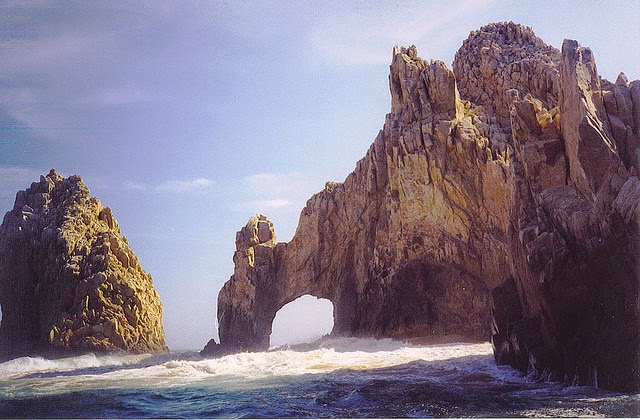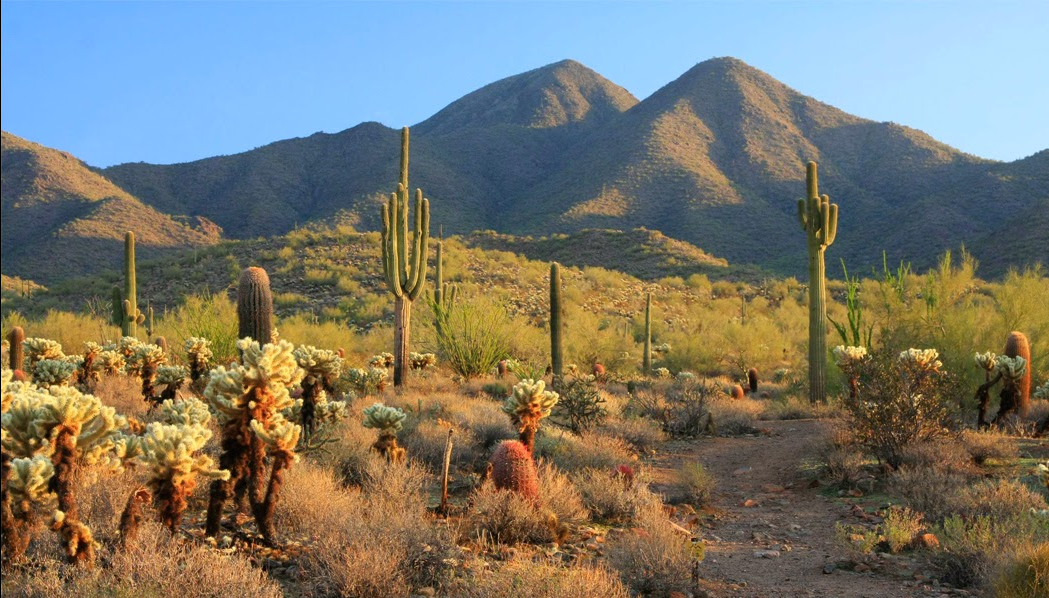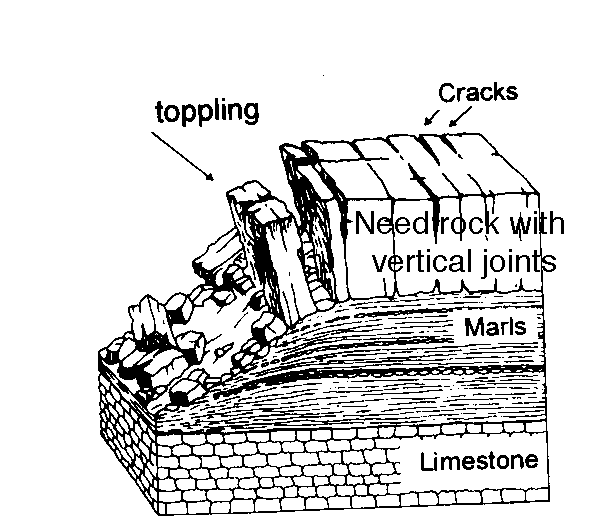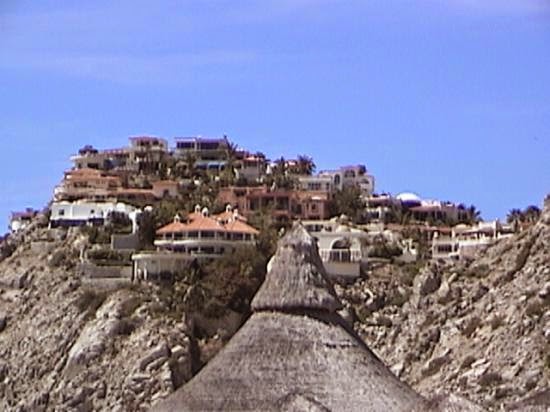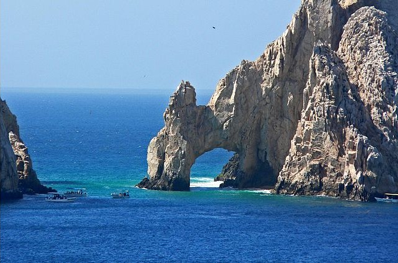Cabo San Lucas's Geography
Cabo San Lucas contains a very unique geography. Not only can the climate be described as arid, but it also features a Mediterranean climate. The southern part of Cabo contains a very dry, desert climate. The northwest region of Cabo may be characterized by the Mediterranean climate, the second part of the Cabo is the Sonora Desert. The desert provides high temperatures, little rainfall, mountainous terrain and cactus like vegetation while the peninsula itself is rich in Mediterranean climate with warm and dry climates.The region of Cabo is extremely hot, humid and affected by hurricanes.
Image from Google
The desert part of Baja California.
Image from intactnature.com
Landscape 10,000 Years from Now
10,000 years from now I predict that Cabo San Lucas will continue having hurricanes every few years. Hurricanes have been present within Cabo San Lucas as recent as 2014. A list of Past Hurricanes that have occurred in Cabo San Lucas may be viewed within this link Cabo Hurricane List. Hurricanes occur when five major ingredients are evident.
2.) High sea surface temperature
3.) Few changes in wind speed
4.) Lots of water vapor (in low levels)
5.) Convergence
Growing Hurricanes
Hurricanes
extract heat, low level warm water is drawn to the center as air rises.
As the positive feedback continues to grow it builds from low pressure
into a tropical storm, then into a hurricane which may become
devastating.
Image from Professor Allen lecture
Categories
Hurricanes differs in strength and category size.The categories are divided into five categories. The most recent Hurricane that has occurred in Cabo San Lucas was classified as a category 3 hurricane. Meaning that wind reached up to 135 mph, with a storm surge that could have reached 12ft. I predict that as the hurricane categories have increased through looking at past Hurricane patterns, Hurricanes should keep around the category of 3 or expand to higher categories as temperatures of the ocean increase.
Image above shows categories of Hurricanes
Image from http://ssdstudent.net/SMS/2010_11/krev/web2/hurricane_chart.jpg
My prediction of Cabo continuing to get hit by hurricanes and those hurricanes expanding in their category size seems practical due to past Hurricane patterns and Cabo's Mediterranean location. The future Hurricanes will also destroy hotels and tourist destinations.
Landscape 1,000,000 Years from Now
1,000,000 years from now I predict that Mass Wasting will bring down hotels, and rock formations located on the edges of cliffs. Mass Wasting can occur by falls, flows, slides, and topples. Mass wasting is the down slope movement of angular slope material. Gravity is a key aspect in mass wasting. Because so many hotels are built on the cliff sides and within the mountainous terrain, that leaves them susceptible to landslides and other forms of mass wasting. Cabo San Lucas would be most susceptible to falls, slides, and topples based on its location.
Falls
Occurs with a steep slope and often undercutting, can be individual rocks or groups.
Flows
Occur when mudflows contain a lot of mud with little rock content.
Image above shows more of all mass wasting.
Slides
Occurs when down slope movement occurs along a plane of weakness in the rock.
Topples
Slopes erode slowly over time, to slowly for us to see. Within 1,000,000 years though mass wasting could occur and alter Cabo San Lucas's geography and tourist destinations. Some of this mass wasting will be seen soon enough, while topples and falls may occur bringing down hotels and luxury homes. But more of this will occur between 1,000,000 years from now because of Cabo's location and climate.
Above image shows a hotel on the terrain.
Image from tripadvisor.com
Landscape 100,000,000 Years from Now
100,000,000 years from now I predict that the famous rock formations, that bring so many tourists to visit Cabo San Lucas will fully decay. El Arco de Cabo San Lucas is a distinctive rock formations located at the very tip of the city known as Lands End. This signature rock formation is an icon of Cabo. Lands End is where the Sea of Cortez and the Pacific Ocean meet. The base of these rock formations are well known for the marine life, coral formations, and tropical fish.
El Arco de Cabo San Lucas, or Lands End, marks the spot where the
Pacific Ocean meets the Sea of Cortez at the southern tip of Cabo San
Lucas, Mexico. Photo by Stan Shebs.
The rock formations are made of granite and have been carved by degradation. The result of weathering is the breaking down of rock in place, the decay of rock. Weathering is the beginning of change to the Earths surface. Two forms of rock decay occur with physical and chemical decay. Physical decay is the disintegration of rocks and mineral by a physical or mechanical process. Chemical decay is the chemical alteration or decomposition of rocks or minerals. El Arco, because of its location within the ocean is prone to the physical decay of salt decay due to ocean surrounding and joints which are regularly spaced fractures or cracks in rocks formed from cooling or expanding, faulting/folding/ and tectonics; as well as the chemical decay of hydration (addition/removal of H20 to a mineral). Because of the arcs surroundings and location years of wind and dissolution(mineral is completely dissolved by the water), water erosion(Ocean current). The Rock strusture has already deterioated due to decay, but it will continue to do so until the rock structure is fully erased. The constant invasion of salt water to the rock structure will completely dissolve the famous rock formations, as well as other rocks.
The rock formations are made of granite and have been carved by degradation. The result of weathering is the breaking down of rock in place, the decay of rock. Weathering is the beginning of change to the Earths surface. Two forms of rock decay occur with physical and chemical decay. Physical decay is the disintegration of rocks and mineral by a physical or mechanical process. Chemical decay is the chemical alteration or decomposition of rocks or minerals. El Arco, because of its location within the ocean is prone to the physical decay of salt decay due to ocean surrounding and joints which are regularly spaced fractures or cracks in rocks formed from cooling or expanding, faulting/folding/ and tectonics; as well as the chemical decay of hydration (addition/removal of H20 to a mineral). Because of the arcs surroundings and location years of wind and dissolution(mineral is completely dissolved by the water), water erosion(Ocean current). The Rock strusture has already deterioated due to decay, but it will continue to do so until the rock structure is fully erased. The constant invasion of salt water to the rock structure will completely dissolve the famous rock formations, as well as other rocks.
Works Cited
http://www.destination360.com/north-america/mexico/cabo-san-lucas/el-arco
http://www.cabosanlucas.net/what_to_do/the-arch-lands-end.php
http://www.cabo.com/cabo-san-lucas/
http://www.cabosanlucas.net/fast_facts/geographical_summary.php
http://www.cabosanlucas.net/fast_facts/geographical_summary.php
Professor Allen Lectures
